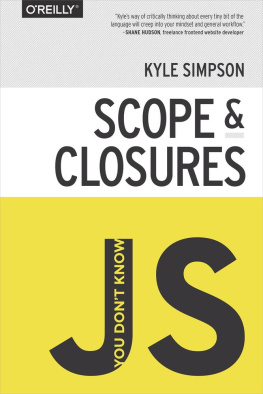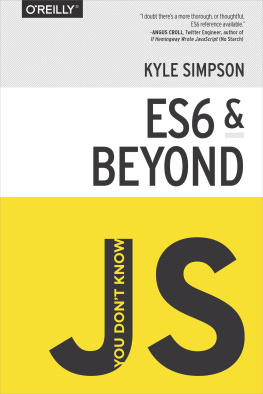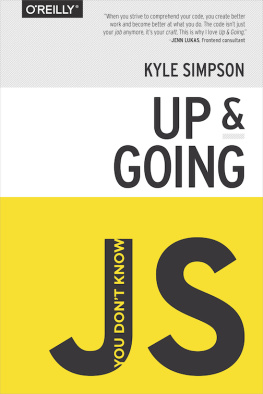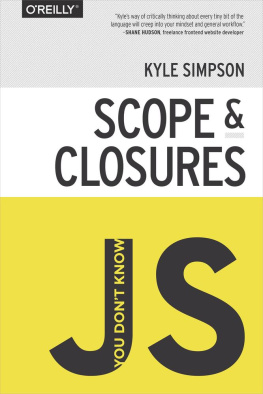Simpson - Scope & closures
Here you can read online Simpson - Scope & closures full text of the book (entire story) in english for free. Download pdf and epub, get meaning, cover and reviews about this ebook. City: Beijing;Cambridge;Farnham, year: 2014, publisher: OReilly Media, Inc., genre: Home and family. Description of the work, (preface) as well as reviews are available. Best literature library LitArk.com created for fans of good reading and offers a wide selection of genres:
Romance novel
Science fiction
Adventure
Detective
Science
History
Home and family
Prose
Art
Politics
Computer
Non-fiction
Religion
Business
Children
Humor
Choose a favorite category and find really read worthwhile books. Enjoy immersion in the world of imagination, feel the emotions of the characters or learn something new for yourself, make an fascinating discovery.
- Book:Scope & closures
- Author:
- Publisher:OReilly Media, Inc.
- Genre:
- Year:2014
- City:Beijing;Cambridge;Farnham
- Rating:4 / 5
- Favourites:Add to favourites
- Your mark:
- 80
- 1
- 2
- 3
- 4
- 5
Scope & closures: summary, description and annotation
We offer to read an annotation, description, summary or preface (depends on what the author of the book "Scope & closures" wrote himself). If you haven't found the necessary information about the book — write in the comments, we will try to find it.
Scope & closures — read online for free the complete book (whole text) full work
Below is the text of the book, divided by pages. System saving the place of the last page read, allows you to conveniently read the book "Scope & closures" online for free, without having to search again every time where you left off. Put a bookmark, and you can go to the page where you finished reading at any time.
Font size:
Interval:
Bookmark:
When I was a young child, I would often enjoy taking things apart andputting them back together againold mobile phones, hi-fi stereos, andanything else I could get my hands on. I was too young to really use thesedevices, but whenever one broke, I would instantly ask if I could figureout how it worked.
I remember once looking at a circuit board for an old radio. It had thisweird long tube with copper wire wrapped around it. I couldnt work out itspurpose, but I immediately went into research mode. What does it do? Why isit in a radio? It doesnt look like the other parts of the circuit board,why? Why does it have copper wrapped around it? What happens if I removethe copper?! Now I know it was a loop antenna, made by wrapping copper wirearound a ferrite rod, which are often used in transistor radios.
Did you ever become addicted to figuring out all of the answers to every why question? Most children do. In fact it is probably my favorite thingabout childrentheir desire to learn.
Unfortunately, now Im considered a professional and spend my days makingthings. When I was young, I loved the idea of one day making the thingsthat I took apart. Of course, most things I make now are with JavaScriptand not ferrite rodsbut close enough! However, despite once loving theidea of making things, I now find myself longing for the desire to figure thingsout. Sure, I often figure out the best way to solve a problem or fix abug, but I rarely take the time to question my tools.
And that is exactly why I am so excited about this You Dont Know JSseries of books. Because its right. I dont know JS. I use JavaScript dayin, day out and have done for many years, but do I really understand it?No. Sure, I understand a lot of it and I often read the specs and themailing lists, but no, I dont understand as much as my inner six-year-old wishes I did.
Scope and Closures is a brilliant start to the series. It is very well targeted at peoplelike me (and hopefully you, too). It doesnt teach JavaScript as if youve never used it,but it does make you realize how little about the inner workings you probably know.It is also coming out at the perfect time: ES6 is finally settling down and implementationacross browsers is going well. If youve not yet made time for learningthe new features (such as let and const), this book will be a great introduction.
So I hope that you enjoy this book, but moreso, that Kyles way ofcritically thinking about how every tiny bit of the language works willcreep into your mindset and general workflow. Instead of just using theantenna, figure out how and why it works.
Im sure you noticed, but JS in the book series title is not an abbreviation for words used to curse about JavaScript, though cursing at the languages quirks is something we can probably all identify with!
From the earliest days of the Web, JavaScript has been a foundational technology that drives interactive experience around the content we consume. While flickering mouse trails and annoying pop-up prompts may be where JavaScript started, nearly two decades later, the technology and capability of JavaScript has grown many orders of magnitude, and few doubt its importance at the heart of the worlds most widely available software platform: the Web.
But as a language, it has perpetually been a target for a great deal of criticism, owing partly to its heritage but even more to its design philosophy. Even the name evokes, as Brendan Eich once put it, dumb kid brother status next to its more mature older brother, Java. But the name is merely an accident of politics and marketing. The two languages are vastly different in many important ways. JavaScript is as related to Java as Carnival is to Car.
Because JavaScript borrows concepts and syntax idioms from several languages, including proud C-style procedural roots as well as subtle, less obvious Scheme/Lisp-style functional roots, it is exceedingly approachable to a broad audience of developers, even those with just little to no programming experience. The Hello World of JavaScript is so simple that the language is inviting and easy to get comfortable with in early exposure.
While JavaScript is perhaps one of the easiest languages to get up and running with, its eccentricities make solid mastery of the language a vastly less common occurrence than in many other languages. Where it takes a pretty in-depth knowledge of a language like C or C++ to write a full-scale program, full-scale production JavaScript can, and often does, barely scratch the surface of what the language can do.
Sophisticated concepts that are deeply rooted into the language tend instead to surface themselves in seemingly simplistic ways, such as passing around functions as callbacks, which encourages the JavaScript developer to just use the language as-is and not worry too much about whats going on under the hood.
It is simultaneously a simple, easy-to-use language that has broad appeal and a complex and nuanced collection of language mechanics that without careful study will elude true understanding even for the most seasoned of JavaScript developers.
Therein lies the paradox of JavaScript, the Achilles heel of the language, the challenge we are presently addressing. Because JavaScript can be used without understanding, the understanding of the language is often never attained.
If at every point that you encounter a surprise or frustration in JavaScript, your response is to add it to the blacklist, as some are accustomed to doing, you soon will be relegated to a hollow shell of the richness of JavaScript.
While this subset has been famously dubbed The Good Parts, I would implore you, dear reader, to instead consider it the The Easy Parts, The Safe Parts, or even The Incomplete Parts.
This You Dont Know JavaScript book series offers a contrary challenge: learn and deeply understand all of JavaScript, even and especially The Tough Parts.
Here, we address head on the tendency of JS developers to learn just enough to get by, without ever forcing themselves to learn exactly how and why the language behaves the way it does. Furthermore, we eschew the common advice to retreat when the road gets rough.
I am not content, nor should you be, at stopping once something just works , and not really knowing why . I gently challenge you to journey down that bumpy road less traveled and embrace all that JavaScript is and can do. With that knowledge, no technique, no framework, no popular buzzword acronym of the week, will be beyond your understanding.
These books each take on specific core parts of the language that are most commonly misunderstood or under-understood, and dive very deep and exhaustively into them. You should come away from reading with a firm confidence in your understanding, not just of the theoretical, but the practical what you need to know bits.
The JavaScript you know right now is probably parts handed down to you by others whove been burned by incomplete understanding. That JavaScript is but a shadow of the true language. You dont really know JavaScript, yet , but if you dig into this series, you will . Read on, my friends. JavaScript awaits you.
JavaScript is awesome. Its easy to learn partially, but much harder to learn completely (or even sufficiently ). When developers encounter confusion, they usually blame the language instead of their lack of understanding. These books aim to fix that, inspiring a strong appreciation for the language you can now, and
Font size:
Interval:
Bookmark:
Similar books «Scope & closures»
Look at similar books to Scope & closures. We have selected literature similar in name and meaning in the hope of providing readers with more options to find new, interesting, not yet read works.
Discussion, reviews of the book Scope & closures and just readers' own opinions. Leave your comments, write what you think about the work, its meaning or the main characters. Specify what exactly you liked and what you didn't like, and why you think so.












![Kyle Simpson [Kyle Simpson] - You Don’t Know JS: Up & Going](/uploads/posts/book/121420/thumbs/kyle-simpson-kyle-simpson-you-don-t-know-js.jpg)




